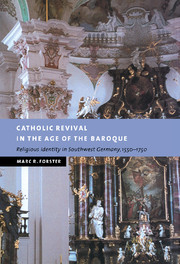Book contents
- Frontmatter
- Contents
- List of maps
- Acknowledgments
- List of abbreviations
- Introduction
- 1 The Counter-Reformation offensive, 1550–1650
- 2 The sacral landscape and pilgrimage piety
- 3 Religious practice
- 4 Clericalism in the villages
- 5 The communal church in German Catholicism
- 6 Reformers and intermediaries, 1650–1750
- Conclusion
- Bibliography
- Index
6 - Reformers and intermediaries, 1650–1750
Published online by Cambridge University Press: 17 July 2009
- Frontmatter
- Contents
- List of maps
- Acknowledgments
- List of abbreviations
- Introduction
- 1 The Counter-Reformation offensive, 1550–1650
- 2 The sacral landscape and pilgrimage piety
- 3 Religious practice
- 4 Clericalism in the villages
- 5 The communal church in German Catholicism
- 6 Reformers and intermediaries, 1650–1750
- Conclusion
- Bibliography
- Index
Summary
Throughout the early modern period, the Catholic elite, both clerics and laypeople, initiated and promoted important changes in Southwest German Catholicism. For the purpose of analysis, this elite can be divided into three groups: the Tridentine reformers, the confessionalizers, and the new orders, primarily the Jesuits and Capuchins. There was, of course, considerable overlap between these groups, but each had a somewhat different set of aims and they clashed quite frequently after 1650 as before. The splits within the reform-minded elements of the Catholic elite were further exacerbated by the presence of important elements within the Church – especially in the monasteries, convents, and military orders – that remained highly skeptical of all reform.
As we saw in chapter I, Tridentine reform was the central program of the Church in Southwest Germany during the period 1580–1620. In this period, church officials, supported (and sometimes pushed) by Catholic secular authorities, engaged in all the standard activities of Tridentine reformers. The Bishops of Constance and neighboring bishops issued reform decrees, held diocesan synods, conducted extensive visitations of rural parishes, punished priests with concubines, and attempted to found and finance an episcopal seminary. Yet these activities had to be abandoned during the Thirty Years' War and were not resumed with the same vigor after the war ended.
- Type
- Chapter
- Information
- Catholic Revival in the Age of the BaroqueReligious Identity in Southwest Germany, 1550–1750, pp. 208 - 240Publisher: Cambridge University PressPrint publication year: 2001



